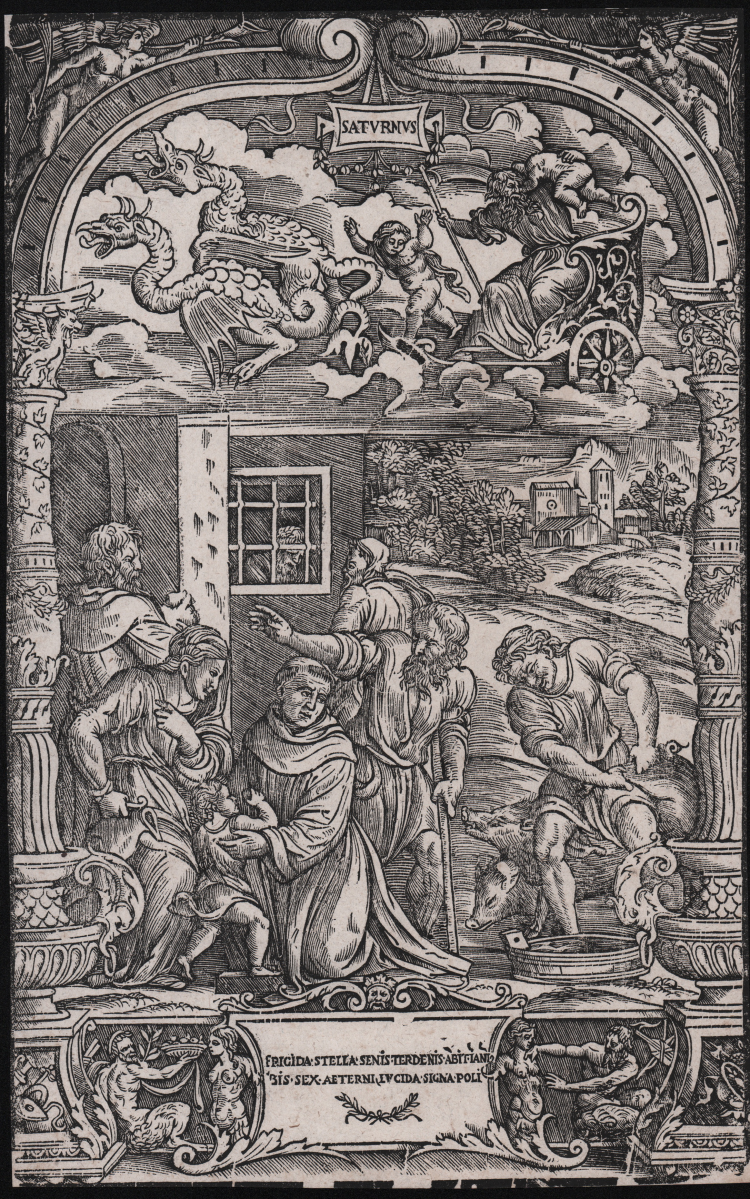




| Reference: | S49648 |
| Author | Girolamo de Grandi |
| Year: | 1533 ca. |
| Measures: | 180 x 285 mm |



| Reference: | S49648 |
| Author | Girolamo de Grandi |
| Year: | 1533 ca. |
| Measures: | 180 x 285 mm |
Woodcut, ca. 1533, lacking signature and editorial indications.
The print shows in the upper part Saturn in a chariot drawn by two dragons, in the act of devouring a child, while another appears to flee; in the lower part several figures appear in a scene that is not well understood: an imprisoned man, a friar with children, a young man with pigs, a woman with a pitcher, and two other figures.
It belongs to a series of Seven Planets attributed to Girolamo de Grandi.
The letters 'G.G.' on some of the sheets - that of Jupiter and also Mercury and Moon - induced the compositions to be attributed to an author with these initials. Lippmann, who first studied the series, referred them to Gabriele Giolito de' Ferrari in 1895, but P. Kristeller (in Thieme-Becker 1921; see also Kristeller 1922) correctly reported the initials to Girolamo de' Grandi, from Ferrara. However, the carving is referred to a Venetian area (cf. Hind). Based on the date on one of the sheets (the one with the Moon), the series is dated to 1533.
The compositional structure of all Seven Planets is the same: the deity on a chariot in the upper part of the sheet, separated by clouds from the lower part, where are a group of men occupied in various activities, all framed by an ever-changing frame (not only for each print, but also, in each sheet, between the left and right sides) that sees festoons and phytomorphic decorative elements, cartouches with the name of the planet at the top, muses or satyrs also bound at the bottom flanking a cartouche with two Latin verses, and two columns of various types flanking the scene. This is a reprise of the famous theme of the Seven Planets and their 'children,' i.e., individuals born under the sign and thus the influence of the planets, which determine their inclinations, passions and activities: as Lippmann (1895) has pointed out, the prototype would be the cycle of burins made in Florence in the 1560s, attributed to burin by Baccio Baldini (Hind 1938-1948, I, pp. 77-83 nn. A.III.1-7), from which several versions are said to have been derived, including one - on wood - carved by a German whom Lippmann identified with HS Beham and whom one is now inclined to recognize as Georg Pencz instead (and of whom several editions are known). The compositional layout and some iconographic details are derived from this German series. The order of the planets should follow what was believed to be the distance from the earth, so from the most distant planet, Saturn, followed in order Jupiter, Mars, Sun, Venus, Mercury, Moon (believed to be a planet).
Few specimens of the series referred to Girolamo de' Grandi are known.
This work on Saturn is known in only three specimens: one in the British Museum, one in KK Berlin, and one in the Vatican Library. The latter two collections hold the complete series of Girolamo de Grandi's Seven Planets.
Beautiful impression, printed on laid paper without watermark, in perfect condition. For quality better proof than the one in the British Museum.
Bibliografia
Aldovini L., Atlante delle xilografie italiane del Rinascimento, ALU.0235; Lippmann F., The seven planets, London, 1895, p. 13, F.II; Kristeller P., Kupferstich und Holzschnitt in vier Jahrhunderten, Berlin, 1922, p. 302; Hind A.M., Early Italian Engraving. A critical catalogue with complete reproduction of all the prints described, New York, 1938-1948, I, p. 78.
Girolamo de Grandi (attivo a Ferrara tra il 1530 ed il 1548)
|
Xilografo, nativo di Ferrara dove fu operoso tra il 1530 e il 1548. Diede disegni per una serie di xilografie, dedicate alla vita di Cristo e della Vergine, una delle quali, l'Incoronazione di Maria (1538), rivela indubbie doti di eleganza e di cultura. Eseguì pure disegni per incisioni di G. Ruina.
|
Girolamo de Grandi (attivo a Ferrara tra il 1530 ed il 1548)
|
Xilografo, nativo di Ferrara dove fu operoso tra il 1530 e il 1548. Diede disegni per una serie di xilografie, dedicate alla vita di Cristo e della Vergine, una delle quali, l'Incoronazione di Maria (1538), rivela indubbie doti di eleganza e di cultura. Eseguì pure disegni per incisioni di G. Ruina.
|